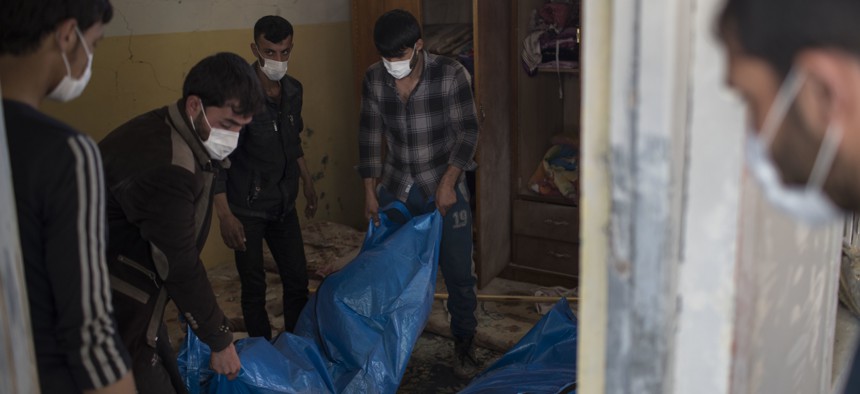
Rsidents carry the body of a person killed in an airstrike during fighting between Iraq security forces and Islamic State on the western side of Mosul, Iraq in March. Felipe Dana/AP
The debate over the increase in civilian casualties caused by the U.S.-led coalition in the campaign against ISIS grows more contentious by the day, even as the tempo of operations has slowed following the fight for Mosul. A dispassionate and systematic internal assessment is long overdue, for the benefit of civilians caught in today’s wars and tomorrow’s — and for U.S. strategic goals.
A study is needed because whether you believe Airwars.com, a well-regarded aggregator of civilian casualties reports, or accept US Central Command’s lower count, there is no doubt civilian casualties have increased significantly over the last six months. At the same time, there is no clear consensus on why. A variety of plausible tactical and operational reasons have surfaced in the media, some of them from the U.S. military itself:
- The shift in fighting to densely populated urban areas such as Mosul
- The delegation of decision-making authority to lower levels of military command
- Faulty intelligence used in airstrike planning
- Lack of on the ground presence for pre- and post-strike evaluations
- More aggressive tactics and a shortened timeline to defeat ISIS
- Uneven professionalism and capacity of local partner security forces on the ground
- ISIS’ use of human shields and other tactics designed to incur civilian harm caused by the coalition
Others believe the increase in casualties reflects political indifference, or even malice, toward civilians by the Trump Administration. Meanwhile, the U.S. military has become publicly exasperated, insisting they do what they can to avoid civilian casualties while the death toll mounts.
Pinpointing the cause of civilian casualties from the outside can be tricky, especially for those without access to the inner workings of government. But history and experience also show that without a specific and dedicated effort, it can be equally tricky, if not impossible, from within too.
In Afghanistan between 2006 and 2008, actions taken by commanders to minimize harm to civilians primarily by limiting air strikes were well intended, but failed to achieve the desired effect. They weren’t based on careful analysis of the data and therefore didn’t address the underlying causes of civilian harm, which extended to gaps in leadership, training, learning, and accountability. Misdiagnosis of these causes led to misgivings and faulty assumptions by outside observers and those in the military about the costs and risks of minimizing civilian casualties, evidence of which still persists today in comments sections of articles about civilian casualties.
This situation only changed when revisions in strategy, tactics, and operational procedures were aligned with the causes of civilian harm. And that alignment was the result of deliberate introspection in the form of studies and assessments of why civilian casualties occurred, conducted by renowned experts like Dr. Larry Lewis. Perhaps the most well-known of these assessments was the 2010 Joint Civilian Casualty Study. Its findings led to broad changes in how U.S. and its partner forces conducted operations. Civilian casualties dropped markedly over time after new commanders adapted operations to the study’s findings.
Given the recent increase in civilian casualties in Iraq and Syria, a similar study would be beneficial for both current and future operations. A new study should examine civilian casualty trends in the campaign, determine the causes of civilian harm, and recommend changes to operations to safeguard civilians while preserving operational effectiveness. And the findings should be shared and examined with other coalition partners.
In addition to consistently reaffirming its commitment to abiding by the laws of armed conflict, the U.S. military says it still believes in the strategic value of avoiding civilian harm. And a July 2016 Executive Order on civilian casualties, which commits the entire U.S. government to draw lessons from operations in order to reduce harm to civilians, remains in place. A comprehensive study is urgently needed to identify and learn the lessons from recent operations in Iraq and Syria. It could save lives in this war, and very well the next.
NEXT STORY: America Is Not Ready for a War in North Korea



